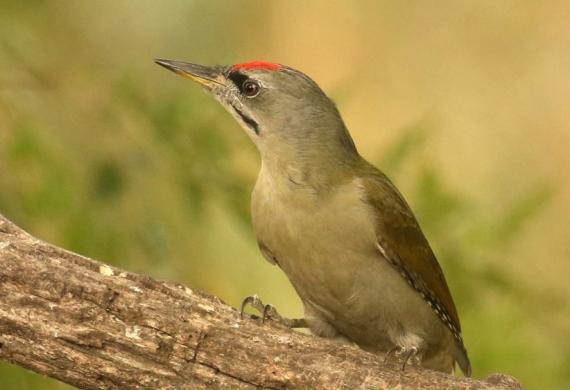Hungary’s Woodpeckers
Woodpeckers (Picidae) are globally widespread, occurring from sea-level to high altitudes on every continent except Oceania (Australia, New Zealand, Papua and islands east of there) and Antarctica. They are absent also from Madagascar and the Arctic. There are more than 200 species worldwide, 11 in Europe, of which 9 occur in Hungary. 8 species are resident and 1, the Wryneck, is migratory. All woodpeckers in Hungary are legally protected.
Fehérhátú fakopáncs (Dendrocopos leucotos) A Harkályvédelmi Szakosztály logójául választott harkályfaj kulcsfontosságú, a természetes állapotú, idős korú, korhadt fában gazdag erdők fontos indikátora. Ez a legritkább, és az egyetlen fokozottan védett harkályfaj Magyarországon. Jelenleg 260-760 párt becsülnek a szakemberek. Csoportunk egyik célja, hogy országos felmérést végezve pontosabb adatokat gyűjtsünk az állomány méretéről, változásáról és veszélyeiről. Bővebb információ

Fehérhátú fakopáncs (Dendrocopos leucotos) / White-backed Woodpecker
Fotó: Gerard Gorman
White-backed Woodpecker (Dendrocopos leucotos) This species was chosen for our group logo because it is a key species, an important indicator of mature, deadwood rich forests. It is the rarest, most range-restricted and hence only Strictly Protected woodpecker species in Hungary. Currently 260-760 breeding pairs are estimated. One of our group’s aims is to conduct a nationwide survey to gather more precise data on its population size, trends and threats. The leucotos subspecies occurs.
Balkáni fakopáncs (Dendrocopos syriacus) Bővebb információ

Balkáni fakopáncs (Dendrocopos syriacus) / Syrian Woodpecker
Fotó: Gerard Gorman
Syrian Woodpecker (Dendrocopos syriacus) Across its range, including Hungary, this species is one of the most ‘urban’ woodpeckers. It is typically found in open, lightly wooded areas, gardens, orchards, vineyards, and other ‘man-made’ habitats. It was first observed in Hungary in the 1930s, having expanded from the Balkans, and quickly spread through most of the country. Today it is common and widespread with 44,000-65,000 pairs estimated, but current trends are unclear.
Nagy fakopáncs (Dendrocopos major) Bővebb információ

Nagy fakopáncs (Dendrocopos major) / Great Spotted Woodpecker
Fotó: Gerard Gorman
Great Spotted Woodpecker (Dendrocopos major) This familiar species is found across Eurasia from the British Isles to Japan and even North Africa. It is the most common and widespread woodpecker in Hungary, a generalist and omnivore that inhabits all kinds of wooded habitats: natural, managed, cultivated, in both rural and urban areas. Over 300,000 pairs and an increasing trend are estimated. The pinetorum subspecies occurs.
Kis fakopáncs (Dryobates minor) Bővebb információ

Kis fakopáncs (Dryobates minor) / Lesser Spotted Woodpecker
Fotó: Gerard Gorman
Lesser Spotted Woodpecker (Dryobates minor) At 14-16 cm the Lesser Spotted Woodpecker is the smallest member of the family in Europe. It is fairly common and widespread in Hungary occurring in most places with broadleaved woodlands, in both uplands and lowlands. It is often probably overlooked however and so its precise distribution and population trends are unclear. Between 12,500-16,500 pairs estimated. The hortorum subspecies occurs.
Közép fakopáncs (Dendrocoptes medius) Bővebb információ

Közép fakopáncs (Dendrocoptes medius) / Middle Spotted Woodpecker
Fotó: Barkóczi Csaba
Middle Spotted Woodpecker (Dendrocoptes medius) Most of the Hungarian population of Middle Spotted Woodpeckers is found in broadleaved woodlands, often with mature oaks, in hilly areas. In the north of Transdanubia, Buda Hills and Mátra Hills a decline in numbers has been noted, but in the south of Transdanubia and north-eastern hills an increase is apparent. Between 23,500-25,500 pairs are estimated nationwide. The nominate medius subspecies occurs.
Zöld küllő (Picus viridis) Bővebb információ

Zöld küllő (Picus viridis) / European Green Woodpecker
Fotó: Gerard Gorman
European Green Woodpecker (Picus viridis) Most of the global population of Green Woodpecker occurs in Europe. It is fairly common and widespread in Hungary, occurring in both lowlands, hilly regions and urban areas, being absent only from closed forests. Between 15,000-17,000 pairs are estimated with an increasing trend suspected. It is highly terrestrial in foraging behaviour, specializing in feeding on ground-dwelling ants. The nominate viridis subspecies occurs.
Hamvas küllő (Picus canus) Bővebb információ

Hamvas küllő (Picus canus) / Grey-headed Woodpecker
Fotó: Gerard Gorman
Grey-headed Woodpecker (Picus canus) The Grey-headed Woodpecker occurs over a vast range, from continental Europe to the Far East. In Hungary it occurs mainly in forested hilly regions, especially with mature broadleaved trees but also in orchards and parkland. It is absent from most lowland areas except for some riverine woodlands. Between 1800-2300 pairs are estimated with a stable trend suspected. It is mostly terrestrial in its foraging habits, feeding on ground-dwelling ants. The nominate canus subspecies occurs.
Fekete harkály (Dryocopus martius) Bővebb információ

Fekete harkály (Dryocopus martius) / Black Woodpecker
Fotó: Csonka Péter
Black Woodpecker (Dryocopus martius) The Black Woodpecker occurs across Eurasia, from continental Europe to the Far East. In Hungary it is fairly common and widespread, inhabiting a great range of forests and woodlands, even lowland plantations and parks, as long as there are some large trees for nesting. In the 20th century the species greatly increased in number and range, today the population is mostly stable. Between 13,500–15,500 pairs are estimated. The nominate martius subspecies occurs as it does across most of the species’ range.
Nyaktekercs (Jynx torquilla) Bővebb információ

Nyaktekercs (Jynx torquilla) / Eurasian Wryneck
Fotó: Gerard Gorman
Eurasian Wryneck (Jynx torquilla) The Wryneck is Europe’s only truly migratory woodpecker. It breeds from continental Europe to the Far East, but winters in Africa and southern Asia. Birds arrive in Hungary from late March and depart by September. It is fairly common and widespread, inhabiting lightly wooded areas, forest edges and orchards. Wrynecks do not excavate their own holes but use those of other woodpeckers, natural tree cavities or nest-boxes. The population is suspected to be in decline, with between 15,700-16,400 pairs estimated. The nominate torquilla subspecies occurs.
